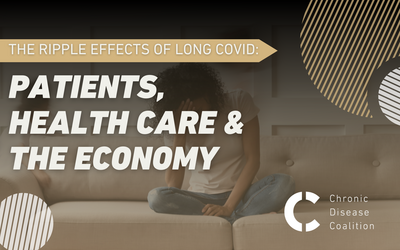
Three years after the national shutdown due to the COVID-19 pandemic, people are still grappling with the effects of the disease. While hospital cases and death tolls are down, a large percentage of the world is battling long COVID. According to the Centers for Disease Control and Prevention, post-COVID conditions can include a wide range of ongoing health problems; these conditions can last weeks, months, or years. Now COVID long-haulers are the newest group of chronic disease patients.
As we navigate this new way of living, we sat down with four experts to shine a light on the research, the symptoms and more. Here’s what they had to say:
Long COVID numbers are dramatically under-estimated
Dr. Robert Popovian, Pharm.D., MS is founder of the strategic consulting firm Conquest Advisors. He also serves as Chief Science Policy Officer at Global Healthy Living Foundation, Senior Healthy Policy Fellow at Progressive Policy Institute, and Visiting Health Policy Fellow at Pioneer Institute. He said that the current estimates of people experiencing long COVID are off.
“The numbers are way underestimated,” said Dr. Popovian. “Brookings Institute did modeling data and I’m working with (the Progressive Policy Institute) and we’re estimating 2-4 million Americans that suffer from long COVID.:”
COVID can change the course of a life
Patient Angi Smith was a social worker and therapist for over 30 years. Before COVID even came on the scene, Angi was managing Ménière disease. Passionate about her work helping people, she started her own practice to maximize her flexibility. But after having COVID in fall 2020 and again in 2022, even her part-time schedule was too hard to manage and she closed her practice.
“I have bad days, and worse days,” Angi said. “I have a lot of family support and I really don’t know what I would have done without it. … It’s not outside the realm of possibilities that I would have ended up homeless. I didn’t have the capacity (to work). I’ve had a lot of memory issues.”
According to Ravindra Ganesh, M.B.B.S., M.D, Consultant in General Internal Medicine and Medical Director of the Post-COVID Care Clinic, at Mayo Clinic in Rochester, MN that type of life-altering change is not unusual.
“We’re seeing people who are running out of economic rope a lot of times... we’re seeing people who, like Angi, are transitioning from being active to really not being able to do much.”
COVID-specialty clinics and telehealth offer better treatment options
Treating long COVID patients is an interdisciplinary effort, according to Dr. Ganesh, that can involve acupuncture, massage, physical therapy, occupational therapy and more. Much of the science is still in progress, which means there’s no set course of treatments that providers can rely on. Clinicians and researchers are working hard to develop treatment recommendations and get them published as quickly as possible.
Having telehealth as an option is also key, as traveling to a doctor’s office can zap a day—or three—worth of energy from a patient.
“We give everyone insurance, but we don’t necessarily give them access,” Dr. Popovian said. He also strongly supports telehealth, but with the caveat that providers receive adequate reimbursement.
The Chronic Disease Coalition advocates for telehealth and payment parity. Read more here.
Vaccines and treatments are still needed, but there are policy solutions and hope
“We can accomplish great things when we choose to put our resources there,” said Nadine Gartner, lawyer, parent, and founding director of Boost Oregon, a parent-led nonprofit organization that empowers people to make science-based vaccine decisions.
“We can solve these problems,” Gartner said. “It’s just a matter of money and resources and energy and making sure our policymakers are fully aware of the issues.”
As a parent to young children and someone who manages Type-1 diabetes, Gartner worked hard to help people understand the safety of the vaccines, and the importance of vaccination—not just for oneself, but for the community and for other families.
“This is still a very serious disease,” she said. Boost Oregon and many other similar organizations will continue to advocate for vaccines, as they continue to be effective at reducing the risk of death, hospitalization, and even long-COVID. Gartner stressed that vaccines weren’t intended to stop infection, but long-term harms.
There is also no end to the search for improved treatments.
“There is a big group of us looking for treatments,” said Dr. Ganesh. “If you get a chance to speak to your congressperson, the things I would advocate for are more … clinical trials and proper funding of long-COVID clinics.”